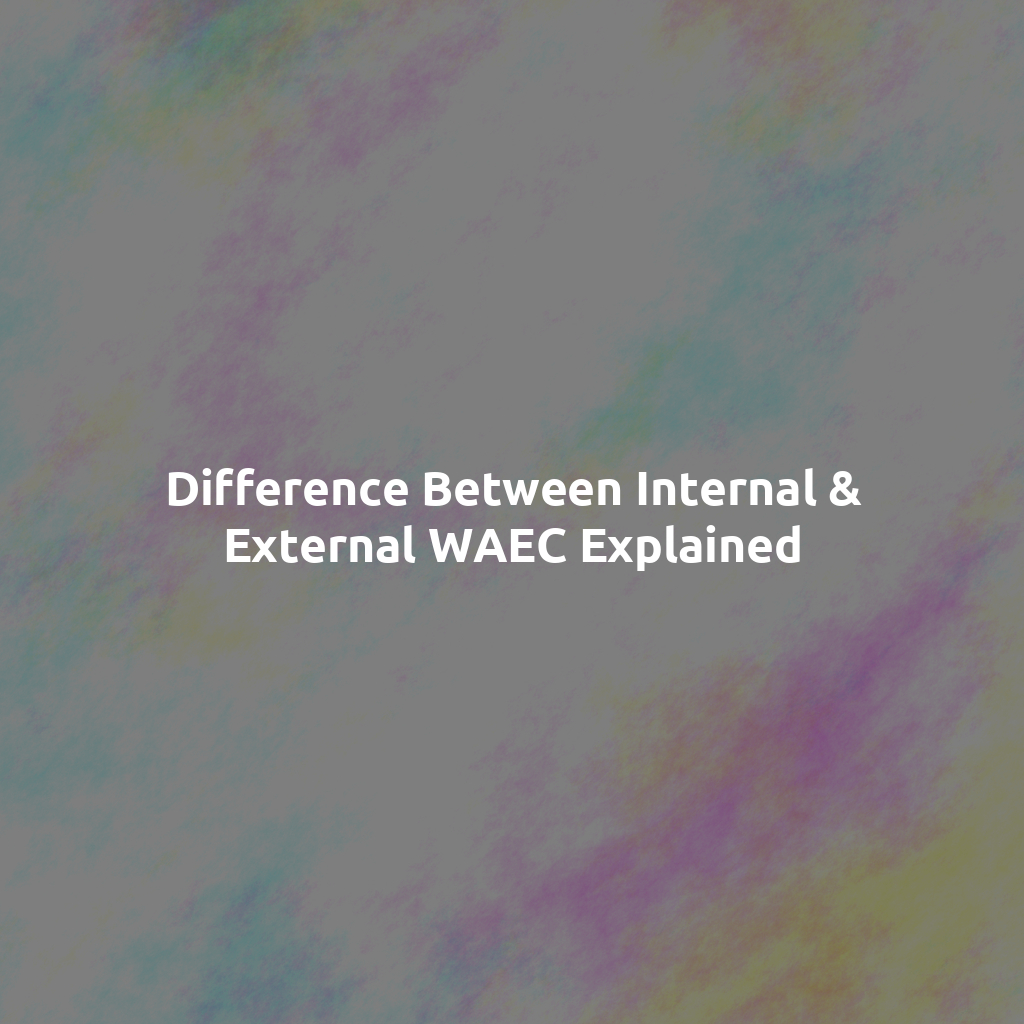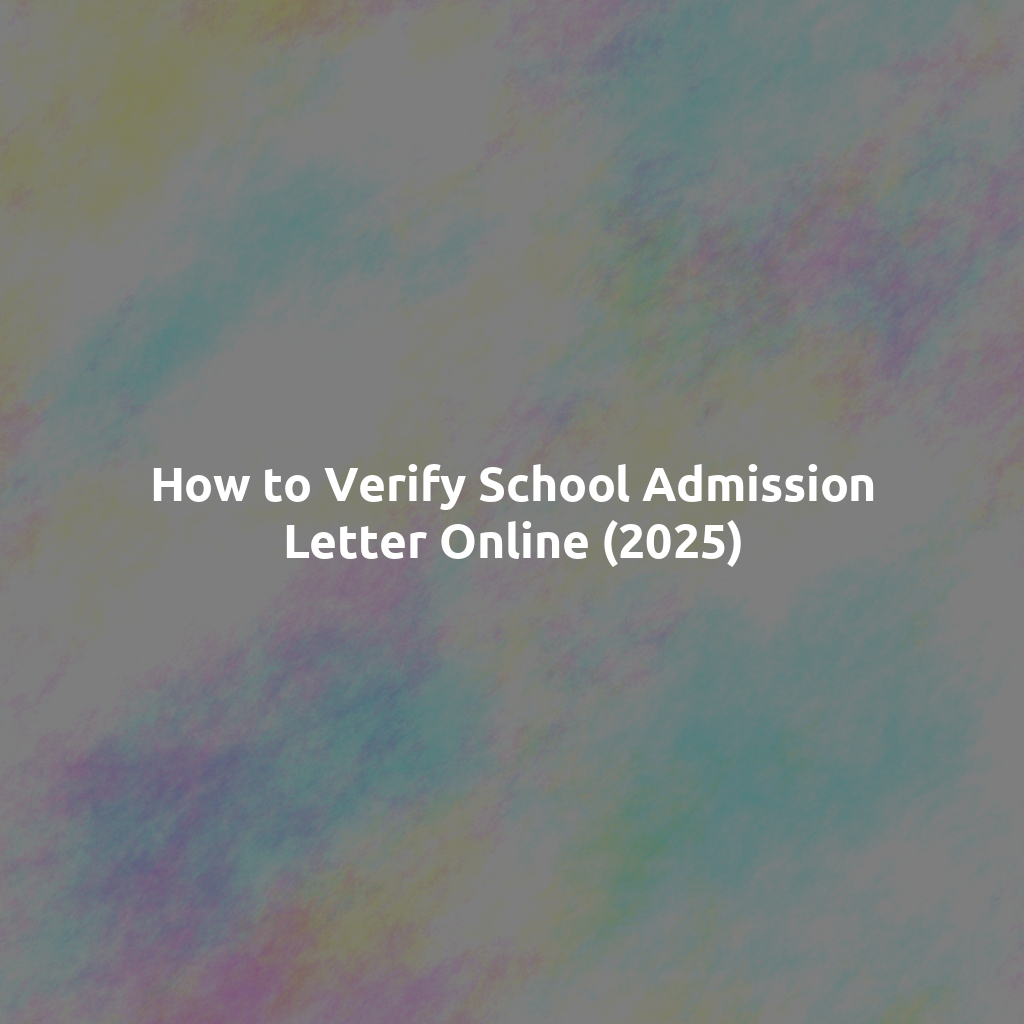Difference Between Internal & External WAEC Explained
Definition of Internal WAEC
Internal WAEC refers to examinations organized by individual schools.
These assessments evaluate students’ knowledge throughout the academic year.
Teachers supervise the examination process within their institutions.
Importantly, the results impact students’ overall grades for the year.
Additionally, internal WAEC allows flexibility in scheduling exams.
Advertisements
Characteristics of Internal WAEC
One key feature is that it aligns with the school’s curriculum.
Teachers often guide students on exam formats and content.
Furthermore, internal WAEC promotes continuous assessment.
It helps identify students needing additional support throughout the year.
Definition of External WAEC
External WAEC consists of standardized examinations conducted by the West African Examinations Council.
These exams usually occur at the end of a specific academic period.
They assess students from different schools using the same criteria.
Moreover, the results are crucial for university admissions.
Characteristics of External WAEC
External WAEC maintains uniformity across all participating schools.
It adheres to a standardized syllabus provided by the council.
Additionally, external assessments offer an objective measure of students’ abilities.
Advertisements
Students generally spend a significant amount of time preparing for these exams.
Key Differences Between Internal and External WAEC
The primary difference lies in the organization of the examinations.
Internal WAEC is school-specific while external WAEC is standardized across a region.
Moreover, internal assessments are ongoing, whereas external exams are scheduled.
The impact of results also varies; internal grades affect yearly performance,
whereas external results influence post-secondary opportunities.
Purpose of Internal WAEC Exams
Internal WAEC exams serve multiple educational purposes.
Primarily, they assess student comprehension of the curriculum.
Additionally, these exams help identify strengths and weaknesses.
Teachers can evaluate their instructional effectiveness through results.
Furthermore, they prepare students for future external assessments.
Enhancing Learning Experience
Internal exams create a continuous learning environment.
They motivate students to engage with the material regularly.
Also, frequent assessments foster better retention of information.
This process helps in building confidence before final exams.
Personalized Feedback
Teachers provide tailored feedback on student performance.
This feedback helps guide individual study plans and strategies.
With such insights, students can focus on specific areas for improvement.
Curriculum Compliance and Evaluation
Internal WAEC exams ensure adherence to curriculum standards.
Schools can evaluate how well they deliver the educational content.
This evaluation often leads to necessary adjustments in teaching methods.
Such alignment enhances overall educational quality in institutions.
Purpose of External WAEC Exams
The West African Examinations Council (WAEC) conducts external exams for numerous reasons.
First, the external WAEC exams offer standardized assessment across different schools.
This ensures that all candidates are evaluated under the same criteria.
Moreover, external exams cater to private candidates who wish to obtain certificates.
These candidates may not be enrolled in traditional schools.
Another purpose involves providing an opportunity for adult learners to pursue their education.
Many adults seek to improve their qualifications without returning to full-time schooling.
Additionally, external WAEC exams help in identifying individual strengths and weaknesses.
Through these assessments, learners can recognize areas needing improvement.
Furthermore, external exams foster a competitive spirit among students.
Competition motivates learners to strive for better results.
Employers and educational institutions recognize WAEC certificates as credible qualifications.
Thus, these exams play a critical role in enhancing career opportunities.
The external WAEC exams support educational and professional aspirations.
Eligibility Criteria for Internal WAEC Candidates
Internal WAEC candidates must be registered students of their schools.
These students usually attend the same institution for a minimum duration.
Typically, this duration is at least three years for secondary education.
Additionally, candidates must be in their final year when they sit for the exams.
Moreover, schools must be recognized and authorized by WAEC.
Students also need to maintain a satisfactory academic performance.
In terms of age, candidates should generally be between 15 and 19 years old.
Furthermore, schools may require their students to meet specific discipline standards.
Participation in mock exams might also be a prerequisite for registration.
Ultimately, all candidates must have their documents verified by school authorities.
These documents include birth certificates and any previous examination slips.
Eligibility Criteria for External WAEC Candidates
General Requirements
External WAEC candidates must meet certain eligibility criteria to register.
Firstly, candidates should have completed their junior secondary education.
Additionally, applicants should be at least sixteen years old.
Moreover, they must not be enrolled in any formal secondary school.
Required Documents
Candidates need specific documents for their registration.
An application form must be completed accurately.
Furthermore, a recent passport photograph is required.
They must also present a valid form of identification.
For instance, a national ID or birth certificate will suffice.
Registration Process
The registration process is straightforward yet important.
Candidates should visit the official WAEC website for details.
They must fill out the online application form with accurate information.
Afterwards, candidates should pay the required examination fee.
Finally, they can print their exam registration slip for future reference.
Examination Subjects
External candidates can select from a broad range of subjects.
These subjects typically include core subjects like Mathematics and English Language.
Moreover, candidates can choose elective subjects based on their interests.
It is essential to check the availability of these subjects during registration.
Preparing for the Examination
Effective preparation is crucial for success in the WAEC exams.
Candidates should create a study schedule to manage their time.
Utilizing past questions can aid in understanding the exam format.
Additionally, attending review classes may enhance their knowledge.
Regular revision will ensure that candidates remain confident.
Assessment Methods Used in Internal WAEC
Classroom Assessments
Classroom assessments play a significant role in internal WAEC evaluations.
Teachers regularly assess students through quizzes and tests.
This helps gauge student understanding and progress over time.
Additionally, frequent feedback enhances students’ learning experiences.
Projects and Assignments
Projects and assignments are crucial components of internal WAEC assessments.
Students engage in individual and group projects throughout the school year.
These projects encourage collaboration and critical thinking.
Teachers use rubrics to evaluate the quality of students’ work.
Practical Examinations
Practical examinations assess students’ hands-on skills and knowledge.
This method is particularly essential for science and technical subjects.
Students demonstrate their abilities in real-world scenarios.
Teachers observe and score students based on performance during these practicals.
Continuous Assessment
Continuous assessment tracks students’ performance over the entire course.
This method includes regular tests, homework, and class participation.
It allows for a comprehensive evaluation of student learning.
Moreover, continuous assessment helps identify areas needing improvement.
Oral Examinations
Oral examinations provide an opportunity to evaluate students’ verbal skills.
Students present their arguments and knowledge on various topics.
This method fosters confidence and enhances communication skills.
Teachers assess clarity of thought and reasoning during these sessions.
Assessment Methods Used in External WAEC
External WAEC assessments utilize a variety of methods.
These methods ensure that the examinations are fair and comprehensive.
One primary method is the written examination.
Written exams evaluate students’ knowledge and understanding of subjects.
Additionally, these exams include multiple-choice questions.
Multiple-choice questions test quick recall and decision-making skills.
Furthermore, essay questions allow deeper analysis and critical thinking.
Oral examinations are also a part of the assessment process.
These assess verbal skills and the ability to articulate thoughts clearly.
Practical examinations are important for science and technical subjects.
They allow hands-on demonstrations of skills learned in class.
Moreover, project work is part of the assessment framework.
This encourages research, creativity, and independent learning.
Each assessment method serves a specific purpose in evaluating student performance.
Ultimately, these varied methods aim to provide a holistic view of each student’s ability.
Differences in Examination Structures between Internal and External WAEC
Overview of Internal WAEC Examination
The Internal WAEC examination occurs within schools.
This format is controlled and monitored by teachers.
It allows for flexible scheduling of exams.
Students often feel more comfortable in familiar settings.
Examination content can reflect the school’s curriculum.
Internal assessments are usually more frequent.
Overview of External WAEC Examination
The External WAEC examination is standardized across regions.
This format is set by the West African Examinations Council.
Students sit for external exams at designated centers.
It ensures uniformity in grading and assessment.
Exams are scheduled at specified times across the board.
Students often experience a higher level of stress.
Comparison of Structure
Internal examinations have a more relaxed structure.
On the other hand, external examinations are highly structured.
Internal exams allow teachers to adjust content based on needs.
But, external exams maintain a fixed syllabus.
Internal assessments provide ongoing feedback to students.
Conversely, external exams provide results after a set period.
Grading Differences
Internal WAEC grades may vary by school and teacher.
In contrast, external grades are standardized for fairness.
Teachers often influence internal grading based on performance.
However, external grading follows strict guidelines.
Internal exams can have a subjective grading approach.
Meanwhile, external exams tend to be more objective.
Implications for Students
Students may benefit from closer teacher support during internal exams.
Yet, external exams prepare them for uniform assessment standards.
Internal exams can foster a supportive learning environment.
External exams emphasize competition among a larger group.
Successful internal exams boost confidence in students.
External exams often determine critical outcomes.
Implications of Results: Internal WAEC vs External WAEC
Understanding Internal WAEC Results
Internal WAEC results are generated from examinations conducted within schools.
The evaluation is typically performed by school teachers or designated internal examiners.
Students generally feel more familiar with the examination environment.
Additionally, they are often assessed on a continuous basis throughout the academic year.
This method allows for a holistic view of student performance.
Furthermore, internal assessments can provide immediate feedback to students.
This feedback helps students identify areas for improvement quickly.
Understanding External WAEC Results
External WAEC results are derived from examinations conducted outside the school environment.
The evaluation is managed by the West African Examinations Council (WAEC).
Students experience a standardized examination format that is uniform across different schools.
This setup often includes a broad range of subjects that test various skills.
Moreover, the results have significant implications for university admissions.
They also play a crucial role in scholarship opportunities and job applications.
Comparative Analysis of Results
The credibility of internal results can be questioned due to potential biases.
In contrast, external results are viewed as more objective and standardized.
Students often perceive internal assessments as less stressful.
However, external examinations may better reflect students’ overall knowledge under pressure.
Additionally, internal results may have different weight in various educational systems.
On the other hand, external results offer a widely recognized standard of achievement.
Implications for Students
Internal WAEC results may influence a student’s immediate academic path.
Students can also benefit from using their internal results for additional support.
Conversely, external WAEC results are critical for securing university placements.
These results often determine qualification for specific courses or programs.
Moreover, students often prepare differently for internal and external assessments.
Proactive preparation strategies can enhance success in both examinations.
Future Academic Paths
Understanding these differences is essential for students and educators alike.
Students should leverage both types of evaluations to improve academically.
Furthermore, educators must ensure a balanced approach to assessments.
Ultimately, both internal and external WAEC results play crucial roles in shaping futures.
Opportunities Available after Passing Internal vs External WAEC
Opportunities for Internal WAEC Candidates
Internal WAEC candidates often enjoy better access to various academic pathways.
Many schools provide specialized programs for these students.
This includes advanced placements in universities and colleges.
Moreover, they can join preparatory classes for their desired courses.
Networking opportunities arise through school events and alumni associations.
Students can also benefit from mentorship programs offered by their institutions.
Job Opportunities for Internal WAEC Candidates
Passing internal WAEC can lead to job opportunities directly after secondary school.
Employers often favor candidates from recognized schools.
Students may find internships and entry-level positions easily available.
Additionally, certain companies conduct recruitment drives in schools.
Opportunities for External WAEC Candidates
External WAEC candidates also have access to various opportunities.
They may enroll in part-time or distance education programs.
These options allow flexibility in their continued education.
Furthermore, external candidates often develop strong self-study skills.
This experience can enhance their employability in various sectors.
Job Opportunities for External WAEC Candidates
Job prospects also exist for those who have passed external WAEC.
Some employers value the independent learning skills of external candidates.
These individuals might access vocational training programs as well.
Moreover, external candidates can pursue entrepreneurship opportunities.
Comparative Insights
Both internal and external WAEC candidates possess unique skills.
Internal candidates may excel in structured environments.
On the other hand, external candidates often showcase adaptability.
Ultimately, both groups can secure successful pathways after graduation.
Emphasizing skills and qualifications remains crucial for all candidates.





